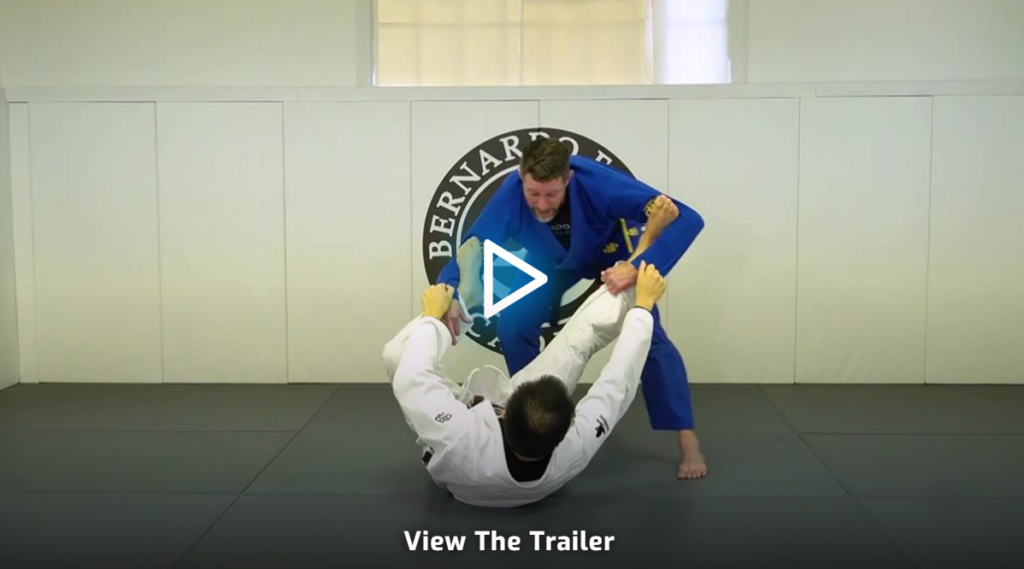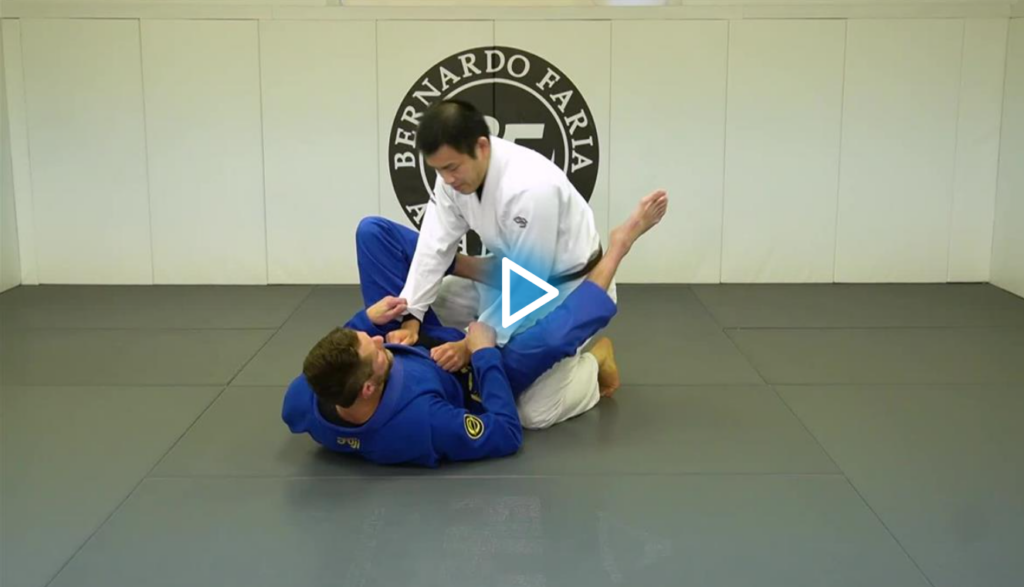
Key Takeaways
- A Gi BJJ instructional offering a modern perspective on the spider and lasso guard.
- Covers using spider and lasso guards against standing and kneeling opponents.
- Features a very specific structure that also goes over ways to pass the guards.
- BJJ World Expert Rating: 7.5 out of 10.
SPIDER AND LASSO GUARD JARED WELMAN DVD AVAILABLE HERE:

I have to be the first to admit that it’s been a while since I played the spider guard. I don’t enjoy having my fingers dislocated from hanging on to sleeves, so it’s not my first choice. The lasso is a different story, as there are ways to mitigate the knuckle pressure and pull it off.
In fact, I did it just the other day and had lots of success preventing a huge and athletic purple belt from passing with ease. The lowdown on these classic Gi BJJ guard positions is that they are timeless in effectiveness. It’s a shame that instructionals such as the Spider and Lasso Guard Jared Welman DVD are few and far between, which leaves us with huge knowledge gaps in the application of these guards in modern Gi Jui-Jitsu.
Where Have Gi Guards Gone?
Gi guards are quite a specific subject. Please note that I am not using the phrase lapel guard, but rather Gi guards. There is a perhaps subtle, but very important difference between the two.
By Gi guards, I refer to guards that you can only play with the Gi on, but not necessarily guards that involve the lapel. The spider guard and lasso guard are the perfect examples. They both involve the use of sleeve grips which cannot be replicated in No-Gi, to begin with.
However, these guards do not require you to half-undress your opponent before you can start working. Instead, they offer efficiency from a position that’s easily attainable anytime you train or compete with the Gi.
So, why have these guards fallen behind in terms of their continued development and use? 15 years ago the spider guard was the hot new thing everyone knew about and was trying to figure out. These days, it’s rare to see someone using it at a high level, let alone build a competition game around it.
The lasso guard shares both the unfortunate fate and the high efficiency and potential of the spider guard. So, when I came across the Spider and Lasso Guard Jared Welman DVD I was both excited about what it rings, but also that someone is breathing a bit of fresh air into these BJJ guard classics.
Who is Jared Welman?
One answer to this question is that Jared Welman is the mobility guy who can fix your body so that it can do Jiu-Jitsu better. Another is that he is an instructor at Bernardo Faria’s academy who can also fix your Jiu-Jitsu game. I guess he is the guy who can fix all your troubles on the mat.
Jared got the huge honor of a BJJ black belt directly from Bernardo Faria. He also has a black belt in Taekwondo and is certified for Yoga. His approach to BJJ is twofold – being super technical by understanding movement and the human body.
To that extent, he has been dedicating a lot of time toward specific mobility for BJJ, from general drills to position-specific stuff. Speaking of positional specifics, Welman has introduced the mobility angle to guards, taking them to a whole new level. His Spider and Lasso Guard Jared Welman DVD is all about that.
Spider and Lasso Guard Jared Welman DVD Review
In the Spider and Lasso Guard Jared Welman DVD, you get the usual four-volume BJJ DVD format, with each part lasting a bit over 30 minutes. What’s different is that this Gi instructional has the same structure applied to each of the volumes with no adjustments of differences whatsoever. Check it out:
Part 1 – Spider Guard vs Kneeling Opponent
This instructional has one of the simplest and most sensible structures I’ve ever seen in a BJJ DVD. Jared addresses two guards and covers how to use each against a kneeling and against a standing opponent.
The Spider and Lasso Guard Jared Welman DVD starts with an overview of the spider guard, and how to set it up against a kneeling opponent. Jared first discusses positional details and tips on tactics that will yield the best results.
He then moves on to explore the attacking opportunities from the guard, offering not just sweeps and submissions, but easy ways to connect them into chains as well. I loved that he also included the other side of the coin, by briefly but thoroughly covering how to pass the spider guard from kneeling.
Part 2 – Spider Guard vs Standing Opponent
Volume two of the Spider and Lasso Guard Jared Welman DVD follows the same structure as the previous part to a ‘t’. Welman starts with positioning again, this time using the spider guard against a much trickier standing opponent.
He lays out the tactical goals first, before offering ways to achieve them by linking together attacks that involve sweeps, submissions, and transitions. For the latter, he offers routes into other guards, leg lock, or that back. Passing rounds off the spider guard portion of this instructional, this time from a standing starting position.
Part 3 – Lasso Guard vs Kneeling Opponent
As we reach the halfway point of the Spider and Lasso Guard Jared Welman DVD, the focus is still on guard, albeit changing now to a completely different structure – the lasso guard. Seen as an advanced guard, this one seems to trouble lots of people, but Jaredd makes it seem really easy.
Once again, positional details and a tactical analysis precede the attacks. With the opponent on their knees, Jared offers a set of sweeps and submissions that are interchangeable and easily accessible from the guard. His take on passing, which makes the end of the volume is a method I haven’t seen before, and which seems very legit for the job.
Part 4 – Lasso Guard vs Standing Opponent
The final piece of the puzzle in the Spider and Lasso Guard Jared Welman DVD is addressing standing opponents when you’re dead set on playing the lasso guard. It’s way more difficult than executing it against a kneeling opponent, but Welman does a solid job again at drawing parallels between the two.
By now, you probably know what to expect – a positional strategy, an overview of key problems and goals, and all the submissions, sweeps, and transitions you need to achieve said goals and solve the problems. Let’s not forget the short, but highly important conclusion that offers passing options as well.
Taking the Arms Away
There is a very dumb-looking drill that perfectly captures the role of the arms in passing the guard in BJJ. Have a partner sit down on the mats, let them grab both your palms with their hands (grips don’t matter), and only focus on not letting them go. Then try to pass.
It doesn’t work, I know. Granted, the bottom person can’t achieve much either, but it helps to put things into perspective. The main thing to understand is that the top person needs to control their arms, in order to pass, and keep the position successfully.
That makes guards that target the arms an obvious choice when you want to retain your guard. They not only mimic the drill above but also place the legs against the arms, which brings the advantage to the bottom player, as well as opening up direct attacks.
The drawback is that the top person tends to be far away for a huge diversity of attacks, but you can definitely still sweep and submit. A key advantage is that you don’t have to change your guard configuration once the top person changes levels. Watch the Spider and Lasso Guard Jared Welman DVD and you’ll understand it all better.

FULL DOWNLOAD: SPIDER AND LASSO GUARD JARED WELMAN DVD
Fix Your Fundamentals
What are fundamentals? A decade ago people thought of the spider guard as an advanced position. These says it’s fundamentals. Who cares. What matters is what you do with it, and that is where the Spider and Lasso Guard Jared Welman DVD fills a big gap. It’s not as if there is no information on the spider and lasso guards already, but there is not a lot of it in terms of modern BJJ. This instructional is here to fix that.


![Darce Choke Encyclopedia – Origins, Mechanics and Variations [2025] BJJ, choke, Brabo, BJJ Darce Choke, D'arce Choke, Darce BJJ Choke](https://bjj-world.com/wp-content/uploads/2017/11/JungPoirierLeeYahoo-218x150.jpg)










![[VIDEO] Ex-UFC Champ Aljamain Sterling Gets Choked Out Cold on Russian TUF-Style Show VIDEO - Aljamain Sterling Gets Choked Out Cold on Russian Reality Show](https://bjj-world.com/wp-content/uploads/2025/04/LEG-GRABS-2-218x150.png)


![Slicin’ Calves Mikey Musumeci DVD Review [2025] Slicin' Calves Mikey Musumeci DVD Review](https://bjj-world.com/wp-content/uploads/2025/04/slicin-calves-mikey-musumeci-dvd-review-218x150.png)
![Jiu-Jitsu For Old Guys Guard Retention Bernardo Faria DVD Review [2025] Jiu-Jitsu For Old Guys Guard Retention Bernardo Faria DVD Review](https://bjj-world.com/wp-content/uploads/2025/03/old-guys-guard-retention-bernardo-faria-dvd-review-218x150.png)
![X-Guard Trickery Kyle Sleeman DVD Review [2025] X-Guard Trickery Kyle Sleeman DVD Review](https://bjj-world.com/wp-content/uploads/2025/03/x-guard-trickery-kyle-sleeman-dvd-review-218x150.png)
![Nicholas Meregali No-Gi System DVD Unpacked: A Detailed Review [2024] Nicholas Meregali No-Gi System DVD Unpacked: A Detailed Review](https://bjj-world.com/wp-content/uploads/2024/09/nicholas-meregali-no-gi-system-dvd-unpacked-review-324x235.png)
![Upper Body Chain Attacks Janine Mocaiber DVD Review [2025] Upper Body Chain Attacks Janine Mocaiber DVD Review](https://bjj-world.com/wp-content/uploads/2025/03/upper-body-chain-attacks-janine-mocaiber-dvd-review-100x70.png)
![Underhooks With Uncle Jeff Glover DVD Review [2025] Underhooks With Uncle Jeff Glover DVD Review](https://bjj-world.com/wp-content/uploads/2025/02/underhooks-with-uncle-jeff-glover-dvd-review-100x70.png)
![Slicin’ Calves Mikey Musumeci DVD Review [2025] Slicin' Calves Mikey Musumeci DVD Review](https://bjj-world.com/wp-content/uploads/2025/04/slicin-calves-mikey-musumeci-dvd-review-100x70.png)

![Jett Thompson Master Ankle and Aoki Lock DVD Review [2024] Jett Thompson Master Ankle and Aoki Lock DVD Review](https://bjj-world.com/wp-content/uploads/2024/09/jett-thompson-master-ankle-and-aoki-lock-dvd-review-100x70.png)

![10th Planet Leg Locks Jeremiah Vance DVD Review [2025] 10th Planet Leg Locks Jeremiah Vance DVD Review](https://bjj-world.com/wp-content/uploads/2025/01/10th-planet-leg-locks-jeremiah-vance-dvd-review-100x70.png)

![Leg Lock Entries Helena Crevar DVD Review [2025] Leg Lock Entries Helena Crevar DVD Review](https://bjj-world.com/wp-content/uploads/2025/03/leg-lock-entries-helena-crevar-dvd-review-100x70.png)
![Countering with Crab Ride Anthony Budion DVD Review [2025] Countering with Crab Ride Anthony Budion DVD Review](https://bjj-world.com/wp-content/uploads/2025/03/countering-with-crab-ride-anthony-budion-dvd-review-100x70.png)

![Shin to Shin Eoghan O’Flanagan DVD Review [2025] Shin to Shin Eoghan O'Flanagan DVD Review](https://bjj-world.com/wp-content/uploads/2024/12/shin-to-shin-eoghan-oflanagan-dvd-review-100x70.png)

![Collar Sleeve Guard Mikey Musumeci DVD Review [2024] Collar Sleeve Guard Mikey Musumeci DVD Review](https://bjj-world.com/wp-content/uploads/2024/12/collar-sleeve-guard-mikey-musumeci-dvd-review-100x70.png)
![Wrestling For Jiu-Jitsu Shawn Williams DVD Review [2025] Wrestling For Jiu-Jitsu Shawn Williams DVD Review](https://bjj-world.com/wp-content/uploads/2025/01/wrestling-for-jiu-jitsu-shawn-williams-dvd-review-100x70.png)

![Slip N Slide Into Victory Julián Espinosa DVD Review [2025] Slip N Slide Into Victory Julián Espinosa DVD Review](https://bjj-world.com/wp-content/uploads/2025/01/slip-n-slide-into-victory-julian-espinosa-dvd-review-100x70.png)

![Jiu-Jitsu For Old Guys Guard Retention Bernardo Faria DVD Review [2025] Jiu-Jitsu For Old Guys Guard Retention Bernardo Faria DVD Review](https://bjj-world.com/wp-content/uploads/2025/03/old-guys-guard-retention-bernardo-faria-dvd-review-100x70.png)
![Baby Shark Guard System Diogo Reis DVD Review [2025] Baby Shark Guard System Diogo Reis DVD Review](https://bjj-world.com/wp-content/uploads/2025/02/baby-shark-guard-system-diogo-reis-dvd-review-100x70.png)

![Highlight Hip Throws Christian Ozbek DVD Review [2025] Highlight Hip Throws Christian Ozbek DVD Review](https://bjj-world.com/wp-content/uploads/2025/01/highlight-hip-throws-christian-ozbek-dvd-review-100x70.png)
![Reverse Arm Bar System Andrew Kerfoot DVD Review [2024] Reverse Arm Bar System Andrew Kerfoot DVD Review](https://bjj-world.com/wp-content/uploads/2024/10/reverse-arm-bar-system-andrew-kerfoot-dvd-review-100x70.png)
![Grappling Takedown Dominance Brandon Ruiz DVD Review [2025] Grappling Takedown Dominance Brandon Ruiz DVD Review](https://bjj-world.com/wp-content/uploads/2025/01/grappling-takedown-dominance-brandon-ruiz-dvd-review-100x70.png)

![Crossing and Spinning Steps To Attack Israel Hernandez DVD Review [2024] Crossing and Spinning Steps To Attack Israel Hernandez DVD Review](https://bjj-world.com/wp-content/uploads/2024/09/spinning-steps-to-attack-israel-hernandez-dvd-review-100x70.png)


